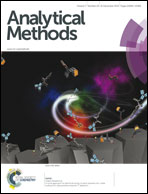Characterization and discrimination of saffron by multisensory systems, SPME-GC-MS and UV-Vis spectrophotometry†
Abstract
Different electronic sensor systems coupled with multivariate data analysis were applied to characterize and classify seven saffron samples and to verify their declared geographical origin. The proposed electronic sensing consists of a low-cost electronic nose (E-nose) based on metal oxide semiconductor sensors and a voltammetric electronic tongue (VE-tongue) based on voltammetric sensors. The ability of multivariable analysis methods such as Principal Component Analysis (PCA), Hierarchical Cluster Analysis (HCA) and Support Vector Machines (SVMs) to classify the saffron samples according to their geographical origin have been investigated. Both PCA and HCA have shown an overlapping of E-nose responses. Moreover, the SVM analysis of the E-nose database reached a 66.07% success rate in the recognition of the saffron sample odour. On the other hand, good discrimination has been reached using PCA and HCA in the VE-tongue characterization case, besides a 100% accuracy in the saffron flavour recognition was attained. To validate the proposed electronic sensing systems, analytical chemical methods such as SPME-GC-MS and UV-Vis spectrophotometry were used. These analytical methods could be helpful tools to identify the composition of volatile compounds of the analysed saffron samples. Moreover, UV-Vis spectrophotometry was also used to determine the non-volatile profile of the samples from different geographic origins. It is demonstrated that the electronic sensing systems' findings are in a satisfactory correlation with the analytical methods. In the light of these results, we might say that the electronic systems offer a fast, simple and efficient tool to recognize the declared geographical origin of the saffron samples.


 Please wait while we load your content...
Please wait while we load your content...